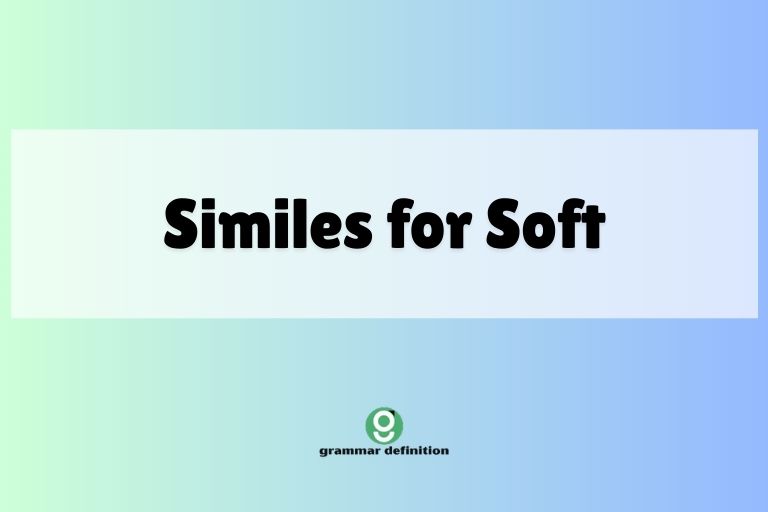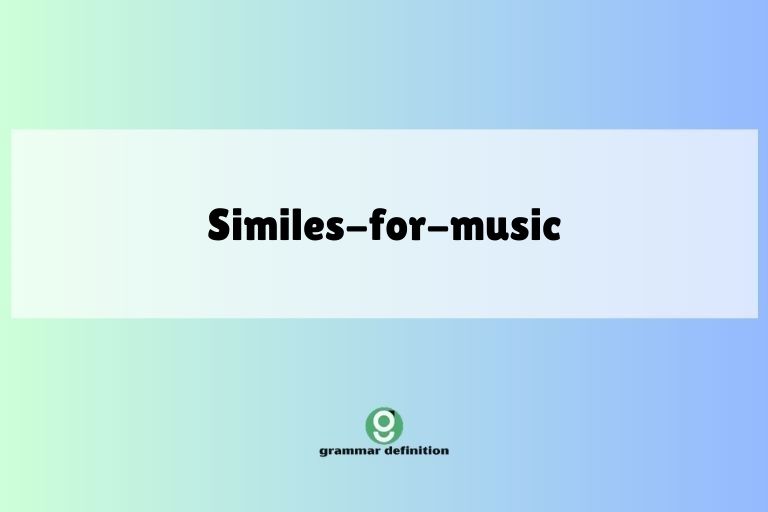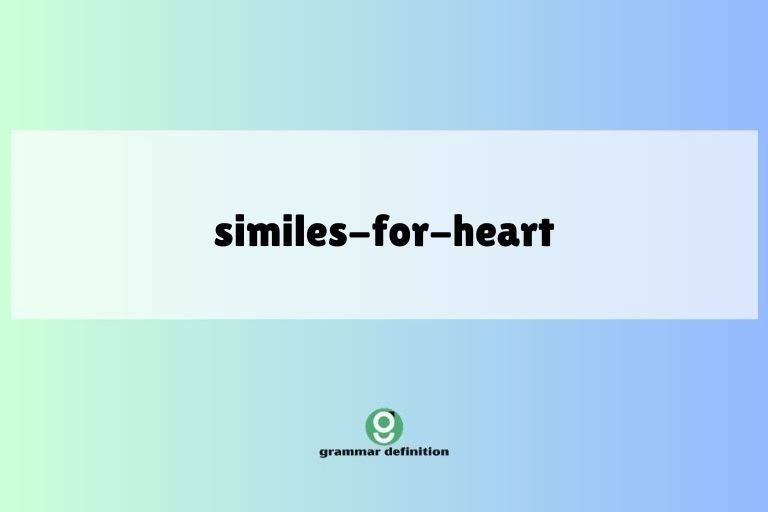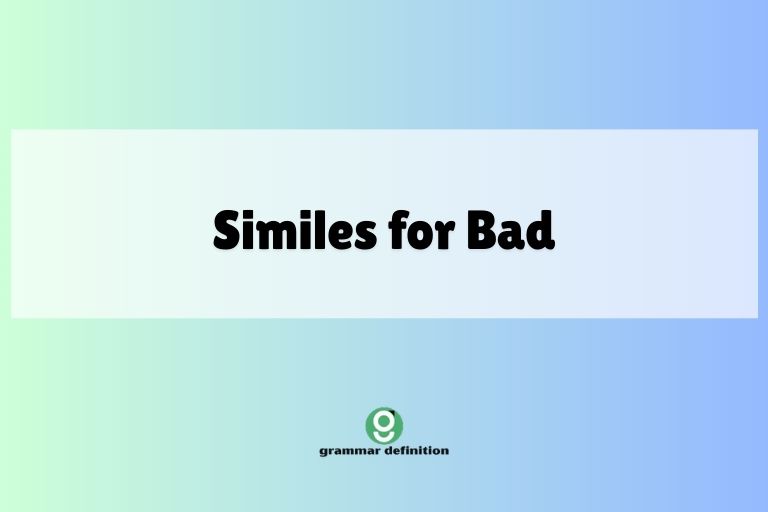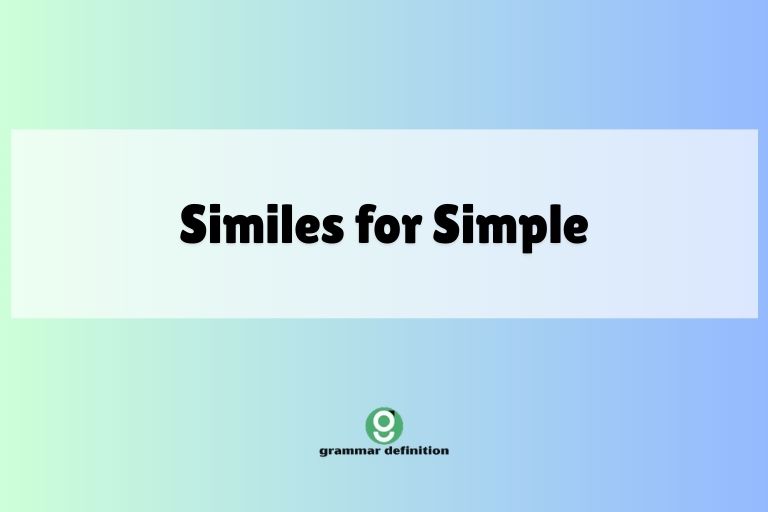Similes for Stupid: A Comprehensive Guide to Figurative Language
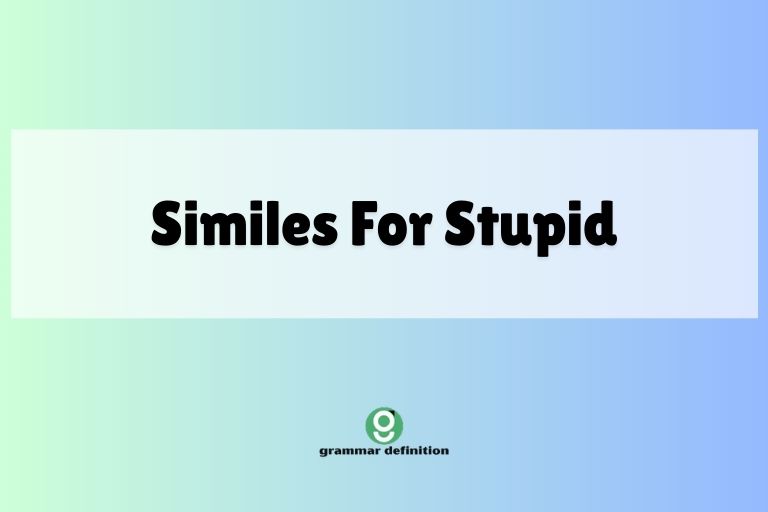
Similes are powerful tools in the English language, allowing us to create vivid comparisons and add depth to our descriptions. When used to describe someone lacking intelligence, similes can be particularly colorful and impactful.
Understanding these similes not only enriches your vocabulary but also enhances your ability to discern nuanced meanings and appreciate the art of figurative language. This article provides a comprehensive exploration of similes used to describe stupidity, their structures, usage rules, and common pitfalls.
This guide is beneficial for English language learners, writers seeking to add flair to their prose, and anyone interested in exploring the expressive capabilities of the English language.
Table of Contents
- Introduction
- Definition of Simile
- Structural Breakdown of Similes
- Types of Similes Describing Stupidity
- Examples of Similes for Stupid
- Usage Rules for Similes
- Common Mistakes When Using Similes
- Practice Exercises
- Advanced Topics: Nuance and Connotation
- Frequently Asked Questions
- Conclusion
Introduction
Similes are figures of speech that compare two unlike things using the words “like” or “as.” They add color, depth, and emphasis to our language. Describing someone’s intelligence (or lack thereof) is a common use of similes.
This article delves into the world of similes that convey stupidity, examining their construction, proper usage, and potential pitfalls. Whether you’re a student, writer, or simply someone who enjoys exploring the nuances of language, this guide will equip you with a better understanding of how similes can be used to express the idea of stupidity in a creative and effective way.
Definition of Simile
A simile is a figure of speech that directly compares two different things using the words “like” or “as.” The purpose of a simile is to create a vivid image or convey a specific quality by associating the subject with something else that shares a similar characteristic. Similes are a type of figurative language, meaning they use words in a non-literal way to achieve a particular effect. They are essential tools for writers and speakers who want to make their language more engaging and memorable.
Similes are classified as figures of comparison. Their function is to draw a parallel between two distinct entities, highlighting a shared attribute.
The context in which a simile is used significantly impacts its interpretation. A simile that might be humorous in one situation could be offensive in another.
Understanding the cultural and social implications of a simile is crucial for effective communication.
Structural Breakdown of Similes
The basic structure of a simile consists of three key components: the subject (the thing being described), the linking word (“like” or “as”), and the reference (the thing to which the subject is being compared). The reference should possess a quality that the speaker or writer wants to attribute to the subject. Let’s break down the structure with examples related to stupidity:
- Subject: The person or thing being described as stupid (e.g., “He,” “The idea”).
- Linking Word: “Like” or “as.”
- Reference: Something known for being stupid or lacking intelligence (e.g., “a rock,” “a doorknob”).
Here are a few examples illustrating this structure:
- “He is as dense as a brick.” (Subject: He; Linking Word: as; Reference: a brick)
- “The idea was like trying to herd cats.” (Subject: The idea; Linking Word: like; Reference: trying to herd cats)
- “She’s as sharp as a marble.” (Subject: She; Linking Word: as; Reference: a marble – ironically used)
The strength of a simile lies in the clarity and aptness of the comparison. A well-chosen simile can instantly convey a complex idea or feeling.
A poorly chosen simile, on the other hand, can be confusing or ineffective.
Types of Similes Describing Stupidity
Similes used to describe stupidity can be categorized based on the specific aspect of foolishness they highlight. Here are a few common types:
Similes Highlighting Lack of Intelligence
These similes directly compare the subject to something known for its lack of intelligence or cognitive ability. They emphasize a general deficiency in understanding or reasoning.
Similes Highlighting Absurdity
These similes focus on the ridiculousness or irrationality of the subject’s actions or ideas. They often involve comparisons to illogical or nonsensical situations.
Similes Highlighting Naivety
These similes emphasize the subject’s lack of experience or worldly knowledge, suggesting a childlike innocence or gullibility.
Similes Highlighting Stubbornness
These similes compare the subject to something inflexible or resistant to change, implying that their stupidity stems from an unwillingness to learn or listen to reason.
Examples of Similes for Stupid
Here are numerous examples of similes used to describe stupidity, categorized for clarity.
Table 1: Similes Highlighting Lack of Intelligence
This table provides examples of similes that directly compare someone’s intelligence to things known for their lack of intelligence.
| Simile | Explanation |
|---|---|
| As dense as a brick | Implies a complete lack of understanding or comprehension. |
| As thick as a plank | Similar to “dense as a brick,” suggesting a slow-witted nature. |
| As dumb as a doornail | Emphasizes a complete absence of intelligence. |
| As bright as a black hole | A sarcastic simile highlighting the absence of intelligence. |
| As sharp as a marble | Another sarcastic simile, implying the opposite of intelligence. |
| Like talking to a wall | Suggests the person is unresponsive and doesn’t understand. |
| As clueless as a newborn baby | Highlights a complete lack of awareness or understanding. |
| Like a deer in headlights | Describes someone who is confused and disoriented. |
| As lost as a sheep in the city | Implies confusion and a lack of direction. |
| As empty as a drum | Suggests a lack of substance or intelligence. |
| As vacant as a parking lot | Implies a lack of thoughts or ideas. |
| As dull as dishwater | Suggests a lack of excitement or intelligence. |
| Like a broken record | Describes someone who repeats the same stupid things. |
| As slow as molasses in January | Implies a slow pace of thinking or understanding. |
| As thick as pea soup | Similar to “dense as a brick,” suggesting a lack of clarity. |
| Like a light bulb with no power | Suggests potential intelligence that is not functioning. |
| As useful as a screen door on a submarine | Implies complete uselessness in a given situation. |
| Like trying to teach a pig to sing | Suggests a futile effort due to inherent limitations. |
| As smart as a bag of hammers | A sarcastic simile highlighting the absence of intelligence. |
| As deep as a puddle | Implies a lack of intellectual depth. |
| As quick as a snail | A sarcastic simile implying the opposite of quickness and intelligence. |
| Like watching paint dry | Suggests a lack of intellectual stimulation. |
| As sharp as a bowling ball | Another sarcastic simile, implying the opposite of intelligence. |
| As bright as a burnt-out bulb | A sarcastic simile highlighting the absence of intelligence. |
| Like a fish out of water | Describes someone who is completely out of their element and confused. |
Table 2: Similes Highlighting Absurdity
This table contains similes that emphasize the absurd or illogical nature of someone’s actions or ideas.
| Simile | Explanation |
|---|---|
| Like trying to herd cats | Suggests a chaotic and impossible task. |
| Like nailing jelly to a tree | Implies an impossible and futile effort. |
| Like rearranging deck chairs on the Titanic | Suggests a pointless activity in the face of disaster. |
| Like bringing sand to the beach | Implies offering something that is already abundant and unnecessary. |
| Like a one-legged man in a butt-kicking contest | Suggests being completely outmatched or ill-equipped. |
| Like a screen door on a submarine | Implies complete uselessness in a given situation. |
| Like shouting into the void | Suggests that no one is listening or understanding. |
| Like trying to catch smoke with your bare hands | Implies an impossible and elusive goal. |
| Like explaining quantum physics to a goldfish | Suggests a task that is far beyond the comprehension of the listener. |
| Like arguing with a brick wall | Implies a futile and frustrating attempt to reason with someone. |
| Like trying to swim upstream in a hurricane | Suggests a difficult and overwhelming challenge. |
| Like looking for a needle in a haystack | Implies a nearly impossible task. |
| Like chasing rainbows | Suggests pursuing an unrealistic or unattainable goal. |
| Like counting grains of sand on a beach | Implies a tedious and endless task. |
| Like teaching a rock to roll | Suggests an impossible task due to inherent limitations. |
| Like trying to fly without wings | Implies attempting something that is inherently impossible. |
| Like whistling in the wind | Suggests a futile and unnoticed effort. |
| Like talking to a broken record | Implies repetition without understanding or progress. |
| Like trying to fit a square peg into a round hole | Suggests forcing something that is incompatible. |
| Like searching for water in the desert | Implies a desperate search where the desired object is unlikely to be found. |
| Like trying to unscramble an egg | Suggests attempting to reverse an irreversible process. |
| Like trying to hold back the ocean with a broom | Implies attempting to control something that is too powerful to manage. |
| Like trying to stop time | Suggests attempting something that is fundamentally impossible. |
Table 3: Similes Highlighting Naivety
This table focuses on similes that emphasize a person’s naivety or lack of worldly experience.
| Simile | Explanation |
|---|---|
| As innocent as a lamb | Implies a lack of awareness of the world’s dangers. |
| As green as grass | Suggests inexperience and a lack of knowledge. |
| As naive as a child | Highlights a childlike innocence and gullibility. |
| As trusting as a puppy | Implies a willingness to believe anything. |
| As wide-eyed as a tourist | Suggests a sense of wonder and unfamiliarity. |
| Like a babe in the woods | Describes someone who is lost and vulnerable. |
| As clueless as a newborn | Highlights a complete lack of awareness or understanding. |
| Like a fish out of water | Suggests being uncomfortable and out of place. |
| As impressionable as clay | Implies easily influenced and molded by others. |
| As gullible as they come | Emphasizes a tendency to believe anything. |
| As unaware as a sleeping bear | Implies a lack of knowledge of current events or surroundings. |
| Like someone who just fell off the turnip truck | Suggests a lack of sophistication and worldly knowledge. |
| As pure as the driven snow | Implies a lack of experience with the darker aspects of life. |
| As unsuspecting as a mouse in a trap | Suggests a lack of awareness of impending danger. |
| As innocent as a newborn baby | Highlights a complete lack of awareness or understanding. |
Table 4: Similes Highlighting Stubbornness
This table includes similes that emphasize a person’s stubbornness or unwillingness to change their mind.
| Simile | Explanation |
|---|---|
| As stubborn as a mule | Implies an unwillingness to listen to reason or change one’s mind. |
| As rigid as a board | Suggests inflexibility and resistance to change. |
| As immovable as a mountain | Implies a steadfast refusal to be moved or persuaded. |
| Like talking to a brick wall | Suggests a futile attempt to reason with someone. |
| As obstinate as an ox | Implies a stubborn and unyielding nature. |
| As firm as a rock | Suggests unwavering resolve and resistance to persuasion. |
| Like trying to bend steel with your bare hands | Implies an impossible task due to the subject’s inflexibility. |
| As unyielding as a tree in a storm | Suggests a refusal to be swayed by external forces. |
| As fixed as the North Star | Implies an unwavering and unchanging position. |
| As set in their ways as an old man | Suggests a resistance to new ideas or changes in routine. |
Usage Rules for Similes
Using similes effectively requires careful consideration of several factors. The comparison should be clear, relevant, and appropriate for the context.
Here are some key rules to keep in mind:
- Clarity: The comparison should be easy to understand. Avoid using obscure or overly complex references.
- Relevance: The reference should share a relevant characteristic with the subject. The connection should be logical and meaningful.
- Appropriateness: The simile should be appropriate for the tone and audience. Avoid using offensive or insensitive comparisons.
- Originality: While common similes can be effective, strive for originality to make your writing more engaging. Avoid clichés whenever possible.
- Context: Always consider the context in which you are using the simile. The meaning and impact of a simile can change depending on the situation.
Exceptions: Sometimes, breaking these rules can be effective for comedic or satirical purposes. However, this should be done intentionally and with careful consideration of the potential impact.
Common Mistakes When Using Similes
Several common mistakes can detract from the effectiveness of similes. Being aware of these pitfalls can help you avoid them in your own writing.
- Using clichés: Overused similes like “as busy as a bee” or “as strong as an ox” can make your writing sound unoriginal and predictable.
- Creating illogical comparisons: The comparison should make sense. Comparing someone to something that has no relevant connection will only confuse the reader.
- Using mixed metaphors and similes: Avoid combining metaphors and similes in a way that creates a confusing or contradictory image.
- Overusing similes: Too many similes can clutter your writing and distract from your message. Use them sparingly and strategically.
Here are some examples of common mistakes:
| Incorrect | Correct | Explanation |
|---|---|---|
| He was as busy as a bee and as sharp as a tack. | He was incredibly busy and remarkably intelligent. | Avoid clichés like “as busy as a bee” and “as sharp as a tack.” |
| She was as graceful as an elephant. | She was as clumsy as an elephant. | Ensure the comparison is logical and relevant to the intended meaning. |
| His idea was a house of cards, like a beacon of hope. | His idea was as fragile as a house of cards. | Avoid mixing metaphors and similes in a confusing way. |
Practice Exercises
Test your understanding of similes with these practice exercises. Fill in the blanks with appropriate comparisons.
Exercise 1: Completing Similes
Complete the following similes with a suitable comparison.
| Question | Answer |
|---|---|
| 1. He was as stubborn as __________. | 1. He was as stubborn as a mule. |
| 2. The idea was as absurd as __________. | 2. The idea was as absurd as trying to herd cats. |
| 3. She was as naive as __________. | 3. She was as naive as a child. |
| 4. He was as dense as __________. | 4. He was as dense as a brick. |
| 5. The task was like __________. | 5. The task was like nailing jelly to a tree. |
| 6. She was as clueless as __________. | 6. She was as clueless as a newborn baby. |
| 7. He was as slow as __________. | 7. He was as slow as molasses in January. |
| 8. It was like talking to __________. | 8. It was like talking to a brick wall. |
| 9. He was as lost as __________. | 9. He was as lost as a sheep in the city. |
| 10. The explanation was as clear as __________. | 10. The explanation was as clear as mud. |
Exercise 2: Identifying Similes
Identify the similes in the following sentences.
| Question | Answer |
|---|---|
| 1. He was as quiet as a mouse. | 1. as quiet as a mouse |
| 2. Her smile was radiant. | 2. No simile present. |
| 3. The task was like finding a needle in a haystack. | 3. like finding a needle in a haystack |
| 4. He is a lion in battle. | 4. No simile present (metaphor). |
| 5. She was as bright as the sun. | 5. as bright as the sun |
| 6. The car was fast. | 6. No simile present. |
| 7. He eats like a pig. | 7. eats like a pig |
| 8. The team played very well. | 8. No simile present. |
| 9. The plan was as solid as a rock. | 9. as solid as a rock |
| 10. The water was cold. | 10. No simile present. |
Exercise 3: Rewriting Sentences with Similes
Rewrite the following sentences using a simile to describe the person’s stupidity.
| Question | Answer |
|---|---|
| 1. He is very unintelligent. | 1. He is as dense as a brick. |
| 2. She is incredibly naive. | 2. She is as naive as a child. |
| 3. His ideas are absurd. | 3. His ideas are like trying to herd cats. |
| 4. He is extremely stubborn. | 4. He is as stubborn as a mule. |
| 5. She does not understand the situation. | 5. She is as clueless as a newborn baby. |
| 6. He doesn’t see the obvious. | 6. He is as blind as a bat. |
| 7. That plan is completely senseless. | 7. That plan is like rearranging deck chairs on the Titanic. |
| 8. He is very slow to understand things. | 8. He is as slow as molasses in January. |
| 9. She is easily tricked. | 9. She is as gullible as they come. |
| 10. Trying to reason with him is pointless. | 10. Talking to him is like talking to a brick wall. |
Advanced Topics: Nuance and Connotation
Beyond the basic structure and usage rules, mastering similes involves understanding nuance and connotation. The same simile can have different meanings and implications depending on the context and the audience.
For example, the simile “as innocent as a lamb” can be endearing in one situation but condescending in another.
Consider the connotations of the reference. A “lamb” evokes feelings of gentleness and vulnerability, while a “rock” suggests hardness and insensitivity.
Choosing the right reference is crucial for conveying the intended meaning and avoiding unintended offense.
Furthermore, the effectiveness of a simile can be enhanced by layering it with irony or sarcasm. For example, saying someone is “as sharp as a marble” is an ironic simile that emphasizes their lack of intelligence.
These advanced techniques require a sophisticated understanding of language and context.
Frequently Asked Questions
Here are some frequently asked questions about similes.
- What is the difference between a simile and a metaphor?
Both similes and metaphors are figures of speech that compare two unlike things. However, a simile uses the words “like” or “as” to make the comparison explicit, while a metaphor implies the comparison without using these words. For example, “He is as brave as a lion” is a simile, while “He is a lion in battle” is a metaphor.
- Can a simile be a cliché?
Yes, a simile can become a cliché if it is overused and loses its impact. Common examples include “as busy as a bee” and “as strong as an ox.” It’s best to avoid clichés and strive for more original comparisons.
- How do I create a good simile?
To create a good simile, choose a reference that is relevant, clear, and appropriate for the context. Strive for originality and consider the connotations of the reference. Avoid clichés and ensure the comparison makes sense.
- Is it okay to use similes in formal writing?
Similes can be used in formal writing, but they should be used sparingly and with careful consideration of the audience and purpose. Avoid overly informal or colloquial comparisons.
- How can I improve my use of similes?
Read widely and pay attention to how other writers use similes. Practice creating your own similes and experiment with different comparisons. Get feedback from others on your writing and be open to criticism.
- Are similes only used to describe people?
No, similes can be used to describe anything, including objects, ideas, and events. The key is to find a relevant and meaningful comparison.
- Why are similes useful in writing?
Similes add color, depth, and emphasis to writing. They can help to create vivid images, convey complex ideas, and make your writing more engaging and memorable.
- What makes a simile “good” or “bad”?
A good simile is clear, relevant, original, and appropriate for the context. A bad simile is cliché, illogical, confusing, or offensive.
Conclusion
Similes are powerful tools for expressing ideas, adding depth, and creating vivid imagery in language. When used to describe intelligence, or the lack thereof, they can be particularly effective, adding humor, sarcasm, or emphasis to your writing or speech.
Understanding the structure, usage rules, and common pitfalls of similes is essential for mastering this important figure of speech. By practicing and experimenting with different comparisons, you can enhance your ability to communicate effectively and creatively.
Remember to consider the context, audience, and connotations of your similes to avoid unintended offense or confusion. Strive for originality and avoid clichés.
With practice, you can become adept at using similes to add color, depth, and impact to your language. Keep exploring, keep practicing, and keep learning!

